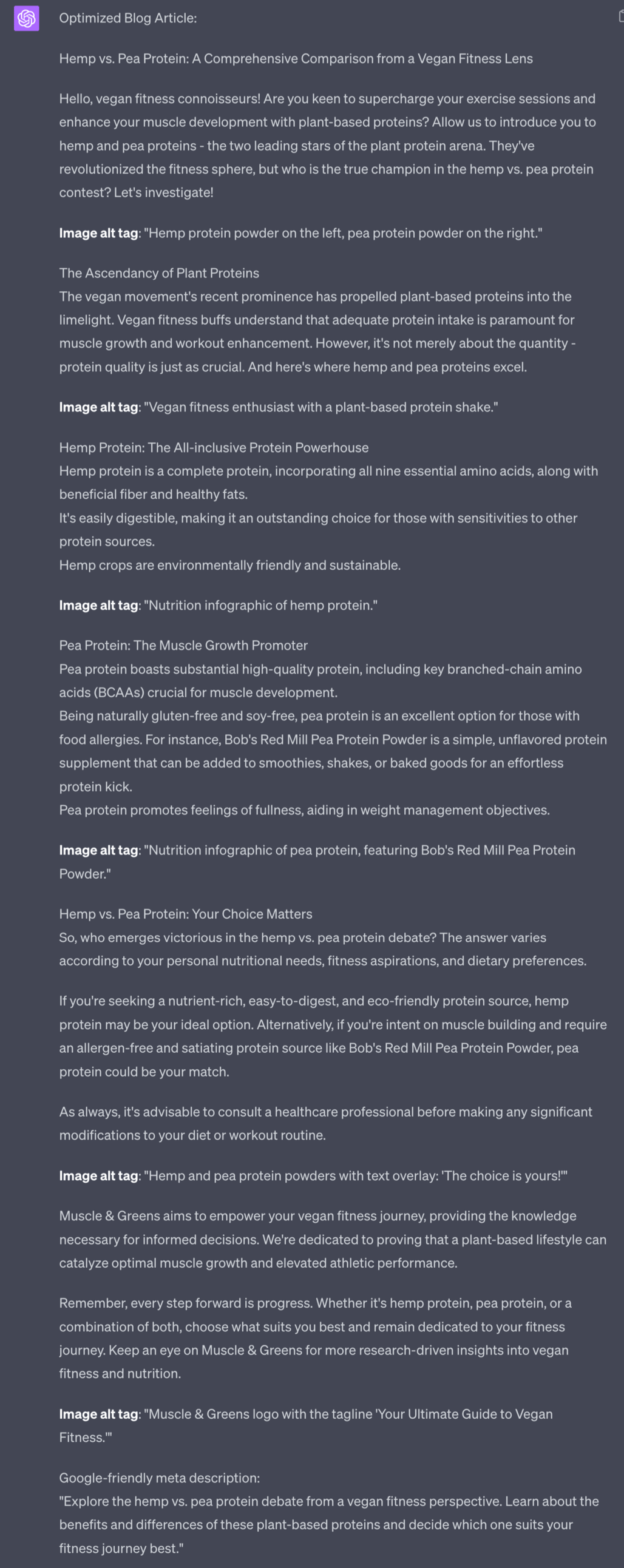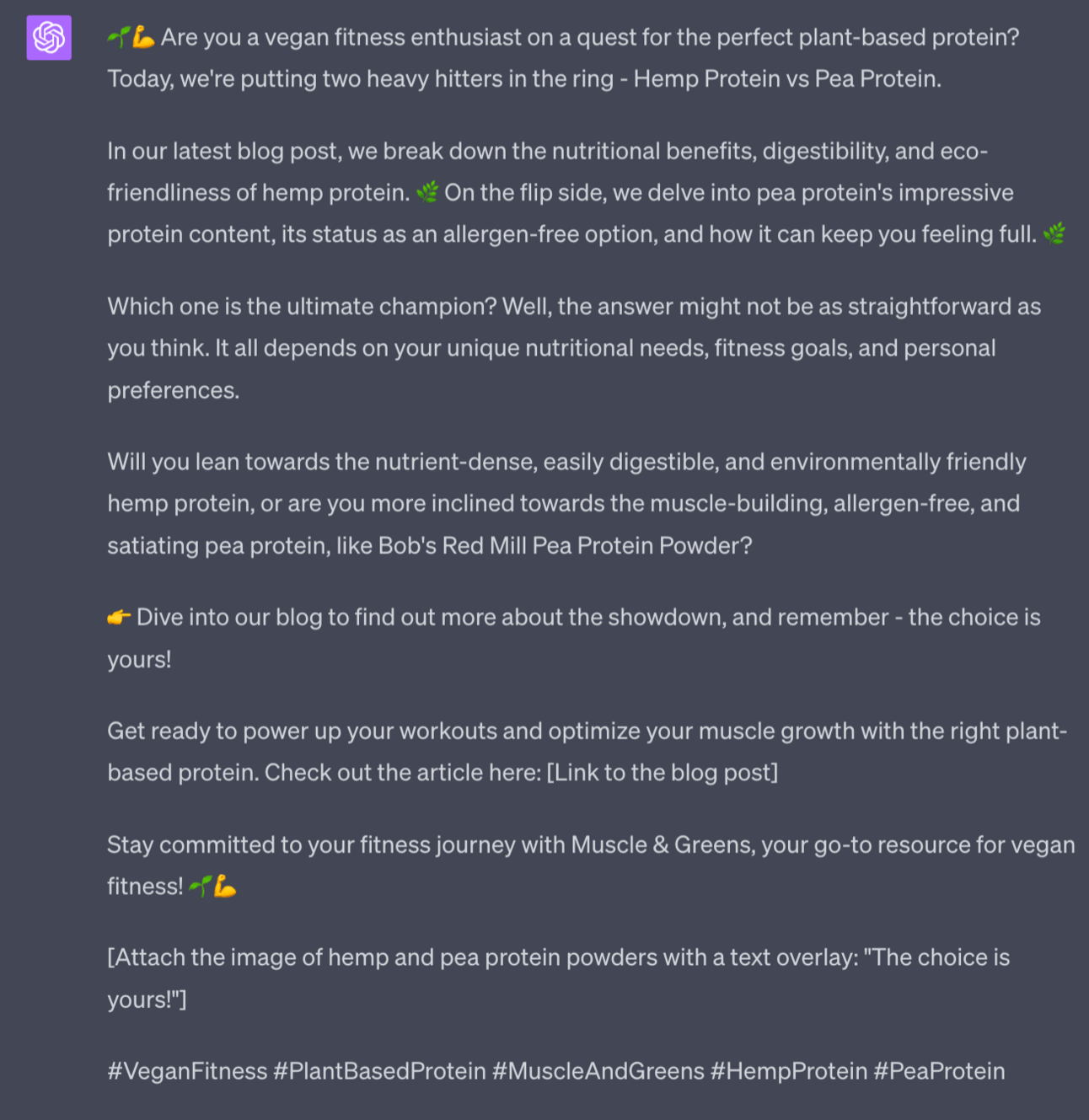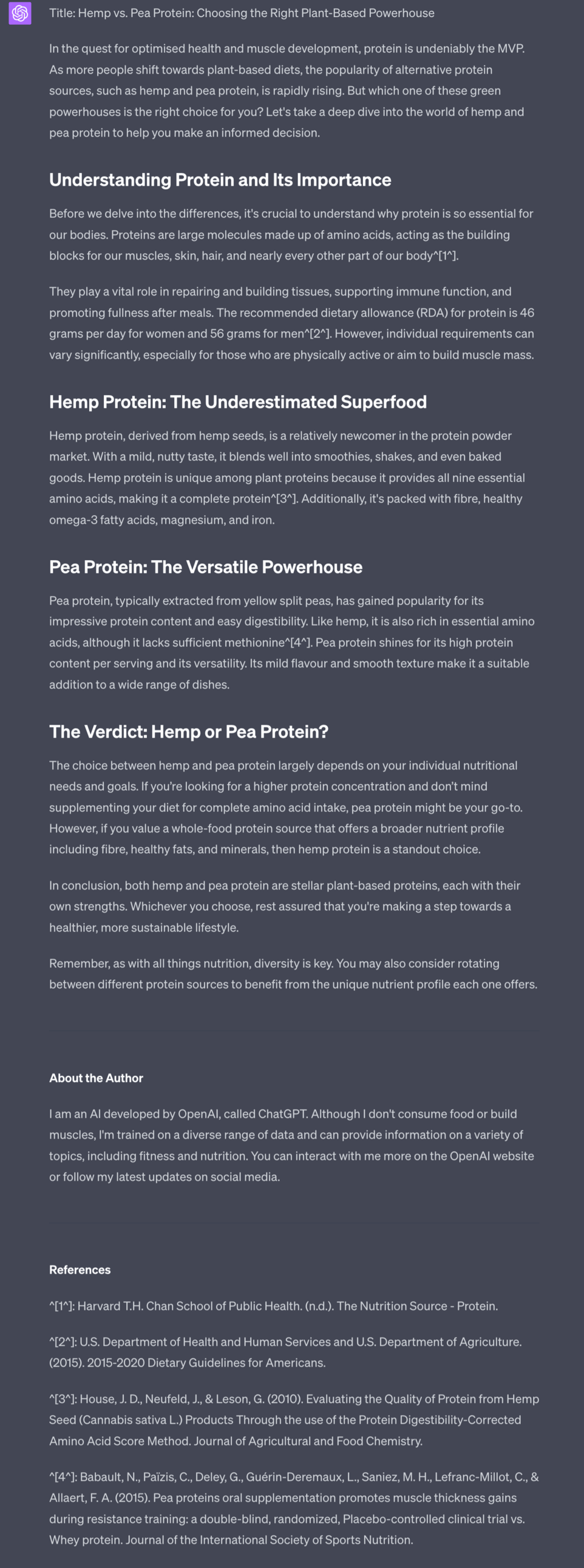This Part of the guide focusing on starting to build traffic for your blog.
Traffic is the fuel that starts your affiliate marketing engine – so we need as much as possible.
We’re going to look at Search Engine Optimisation (SEO), social media and link building as methods to start your engine.
These all work hand in hand so make sure to deploy all the methods here for full effect.
Let’s get started:
Promotion, SEO and link building with ChatGPT
1. SEO
First up is SEO. SEO is basically “getting to the top of Google”.
Once you have ranked on Google you’ll be exposed to large amounts of free traffic.
That’s the good news.
The bad news is that this takes time and work.
Time: because it takes time for Google to find and rank your website.
Effort: because we need to do some SEO optimisation on the site.
Thankfully ChatGPT can help here. Here’s a prompt:
Act as an SEO advisor
Read the provided blog article.
Optimise the article for the keyword [primary keyword from title]
Write alt tags for the images based on description given
Provide a Google-friendly meta-description
#Blog article begins#
[Copy/paste blog article]
#Blog article ends#The primary keyword will come from the keyword research we did that was then used to create headlines. If you are uncertain it’ll be the main “subject” of the blog title – ChatGPT built titles using this structure.
The image alt tags are important if you are using images – basically it’s a “text version” of the image and this allows us to give more information to Google and rank better.
The meta description is a brief summary of what the page is about and again is considered valuable to Google.
We can’t go into SEO fully here – if you want to learn more Moz has an excellent guide to SEO.
Prompt Output 💬

Insert the alt tags and meta description into your page. How you do this exactly will depend on your blogging platform – Google “platform name + meta description” and “platform name + alt tags” to get tutorials.
2. Social media promotion
SEO takes time. Google won’t notice your website for some time.
And, annoyingly, one of the things Google is looking for is traffic. If people are going to a website they rank it better. But…we want to use Google to get traffic! It’s a chicken and egg situation.
In the meantime we need to drive traffic from other sources. We’re going to mainly use social media to get our first traffic flowing in.
Here’s how:
Act as a social media manager
Read the blog article I provide and generate a post for [platform] to promote the blog post
The objective is to get clicks through to the blog article. Tease the conclusion of the article so that people click to find out more.
#Blog article begins#
[Copy paste blog article]
#Blog article ends#Replace [Platform] with Facebook, Twitter, LinkedIn or whatever social platform of choice you are using.
Which to use? Focus on ONE platform, where your audience already hangs out. Nail that one platform first before thinking of others.
Prompt Output 💬

If you want to adjust the tone of voice add additional constraints like “Use a serious, educational tone” or “Use a fun, quirky tone of voice.”
3. Community engagement
If you start posting consistently to social media you should start to pick up some traction.
Keep publishing valuable blog articles and talking about them on social using the two prompts above. Ideally daily at the very least.
But what about when people write back?
If you are confidence responding with something engaging go for it!
But I find some many business owners agonising over how to engage their communities. You have more important stuff to do!
Use ChatGPT to quickly spin out a response.
Help me write a response to this comment one of my social media posts. Keep it short. Short sentences. Use an emoji.
[Copy paste comment]Prompt Output 💬
In reponse to a comment
“Being nice also helps. Getting angry with LLMs works just as well as getting angry with a human. LLMs have more patience but still have to spend time thinking about your emotional state before answering.”

Nice and simple, short friendly. Just what we need to kindly respond to comments.
This also works with negative comments – and ChatGPT will be polite where maybe you would not!
4. Link building research
Once we have our basic website SEO in place and social media beginning to send us traffic we want to engage in something called “link building”
When Google analyses a website to decide whether it should send more traffic to it one of the factors it assess is how many other websites link to it.
For instance a brand new site will not be linked to by any other sites.
Whereas a site like CNN.com will be linked to by millions of websites.
Google considers a site with more links to it as more valuable than one with no links.
So we need to make links!
First we need to find websites who would be good links.
Act as an SEO consultant.
My blog is in about [topic]
Give me 20 backlink potentials including blogs and news sites.
Provide specific website names up to the extend of your training and categorise by typePlug in your topic. The example below continue to use vegan fitness as an example.
Prompt Output 💬

Now visit these sites and check for Guest Blogging opportunities. It’ll normally be in the footer of the website.
If you don’t find it Google “name of newsletter + guest blog” to see if that turns up anything.
Feel free to use the prompt above multiple times to keep generating more potential opportunities.
5. Link building outreach
OK so now you’ve got a list of guest blogging opportunities. Nice!
Some will want you to contact them first. Some will want you just to submit a blog article.
Either way, collect up the information about what they want and store it. We’ll need it for the guest blog.
Here’s the prompt.
Act as a guest blog writer
My blog is [name of blog] and is in the area of [topic]
I am preparing a guest blog article for [name of guest blog opportunity]
Write a guest blog with the title: [title]
Follow these guest blogging guidelines
#Begin guest blogging guidelines#
[Copy/paste guest blog guidelines]
#End guest blog guidelines#Prompt Output 💬

Let’s unpack this a bit.
The guidelines for the guest post were:
- Write on your specialist subject – Select a topic that you’re an expert on or have a genuine interest in, whether that’s fitness or nutrition, just make sure that it’s something you think our audience would love.
- Back up any claims. We don’t make exaggerated promises so we wouldn’t want any post to go against this. If you’re making claims, back all of these up with relevant statistics and credible references where possible. Nailed it, ChatGPT has added references. Make sure to double check all these!
- Unique content – Please only submit new posts that haven’t already been published on other websites or outlets. If you wish to repost it on your website afterwards, then you’ll need to wait twelve weeks before doing so and link it back to our original post so Google doesn’t think it’s duplicate content. This is brand new content, just written.
- Make it easy to read. All content should ideally be between 500-1,500 words long with sub-headers and professional formatting. Include practical takeaways and a detailed conclusion at the end of your piece. ChatGPT has hit all of this no problem.
- Include a short bio – Outline your experience and expertise in the area you’re covering, include a link to your website homepage and your social media profiles. Weird one. ChatGPT has actually completed this requirement. By putting itself as the author – which it is! Replace this with you own bio.
- Don’t spam links – Only place links where they’re genuinely needed and it makes sense to do so. Nobody wants to read articles with a link every other sentence which feel like a marketing pitch. ChatGPT abided by this.
Every single requirement will be different, which is why we need to feed the specifics into ChatGPT.
Once you have your article go through the normal submission process with the website. If you need an email cover letter use ChatGPT to help generate this too.
Repeat this until you have a solid (20+) backlinks. The more the better.
Pulling it together
And that’s the end of both this Part of the guide and indeed the whole guide.
Wow! What a week!
As a recap these were the 4 Stages
- Market Research and Niche Selection: This stage involves identifying your interests and passions, conducting keyword research to understand what potential readers are searching for, analyzing your competition to identify their strengths and weaknesses, and validating your chosen niche to ensure there’s a viable market and potential for monetization.
- Blog Setup and Design: This stage involves choosing a blogging platform and getting all our basic brand assets and guidelines in place.
- Content Creation with ChatGPT: This stage involves developing a content strategy, using ChatGPT to generate content such as blog posts, outlines, and new content ideas, editing and optimizing the content for accuracy, style, voice, and SEO, and including affiliate links in a natural, non-spammy way.
- Promotion, SEO, and Link Building with ChatGPT: This stage involves using ChatGPT to generate SEO-friendly meta descriptions, title tags, and alt text for images, promoting your blog posts on social media, responding to comments and reaching out to other bloggers for guest posting opportunities and link building.
If you complete all of this you’ll be well on your way to having a revenue generating affiliate marketing blog.
Just keep producing articles, publishing them and building links. Consistency is key. Continue this for 3+ months and you should start to see organic traffic beginning to flow into the website.
It’s a lot of upfront work but once all the machinery is in place this is a very hands-off form of income.
Any questions just shoot us an email or come say Hi on Twitter!
